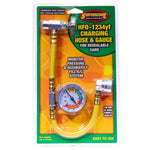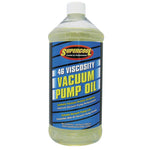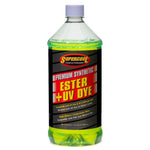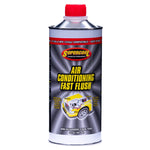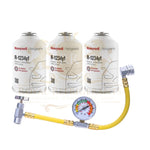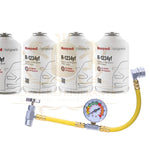You have no items in your shopping cart.
Everything You Need to Know About Refrigerant 408A for HVAC and Automotive Applications
When it comes to refrigerants used in HVAC and refrigeration systems, R408A (also known as Freon™ 408A) has earned a niche reputation as a replacement blend for R502 and R22 in low- and medium-temperature applications. While it’s not as widely used today due to the shift toward lower-GWP alternatives, it still plays a role in servicing older equipment.
This guide explains what R408A is, how it works, where it’s used, its pressure and temperature properties, and why it’s being phased out — plus what your modern alternatives are for HVAC and automotive systems.
What Is Refrigerant R408A?
R408A is a hydrochlorofluorocarbon (HCFC) and hydrofluorocarbon (HFC) blend developed as a retrofit for R502 and R22 systems.
It is a non-azeotropic mixture, meaning its components boil at slightly different temperatures (temperature glide), and must always be charged as a liquid to maintain the correct composition.
📦 Composition of R408A:
| Component | Chemical | Percentage |
|---|---|---|
| R22 | Chlorodifluoromethane | 47% |
| R143a | 1,1,1-Trifluoroethane | 46% |
| R125 | Pentafluoroethane | 7% |
R408A is a zeotropic blend, which means it has a small temperature glide (about 1°F to 2°F).

Key Characteristics
| Property | R408A | R502 (Original) |
|---|---|---|
| Chemical Type | HCFC/HFC blend | CFC blend |
| Ozone Depletion Potential (ODP) | Low (≈0.02) | High (≈0.22) |
| Global Warming Potential (GWP) | ~3,260 | ~4,650 |
| Lubricant Compatibility | Mineral or Alkylbenzene Oil | Mineral Oil |
| ASHRAE Safety Class | A1 (Non-flammable, Low Toxicity) | A1 |
While R408A reduces ozone depletion compared to R502, its GWP remains high — which is why it is also being phased out globally under the Montreal Protocol and regional regulations.
Applications of R408A
R408A was designed as a retrofit refrigerant for:
- Commercial refrigeration (supermarket freezers, display cases, cold rooms)
- Low- and medium-temperature systems that originally used R502 or R22
- Ice machines and refrigerated transport
- Industrial process refrigeration
⚠️ Note: R408A is not used in automotive air conditioning systems. Its pressure and thermodynamic properties make it unsuitable for mobile A/C applications.
Advantages of Using R408A
✅ Drop-in replacement for R502 and R22
It was formulated to allow older R502 systems to continue operating without major component changes.
✅ Non-flammable and safe
It falls under ASHRAE Safety Group A1, meaning it’s non-toxic and non-flammable under normal use.
✅ Similar performance to R502
It offers comparable cooling capacity and efficiency, making it a good transitional option.
Limitations and Concerns
❌ High Global Warming Potential (GWP)
Although safer for ozone than R502, R408A’s GWP (~3,260) is still very high, leading to phase-down under global HFC reduction programs.
❌ HCFC Content (R22)
Because R408A contains nearly 50% R22, it is subject to HCFC phase-out regulations. Production and import of R22 and blends containing it are restricted or banned in many countries.
❌ Not suitable for new equipment
It’s only approved for retrofits — new systems are designed to run on environmentally friendly alternatives like R448A, R449A, or CO₂.
❌ Requires liquid charging
Since it’s a zeotropic blend, R408A must be charged as a liquid to maintain its composition. Charging as a vapor can cause component separation and performance loss.
Pressure–Temperature Chart (R408A)
| Temperature (°F) | Pressure (PSIG) |
|---|---|
| -40 | 1.8 |
| -20 | 14 |
| 0 | 30 |
| 20 | 50 |
| 40 | 76 |
| 60 | 110 |
| 80 | 152 |
| 100 | 206 |
| 120 | 273 |
(Values are approximate; always consult the manufacturer’s data sheet for precision.)
Environmental Regulations and Phase-Out Timeline
🌍 Global Context
- Under the Montreal Protocol, HCFC-based refrigerants (like R22 and blends containing R22 such as R408A) are being phased out worldwide.
- New production of R408A is banned in most developed countries, but reclaimed or recycled refrigerant may still be used for service in existing systems.
🇺🇸 In the United States (EPA Regulations)
- Production/import of HCFC-containing refrigerants (including R408A) ended after January 1, 2020.
- Only reclaimed or recovered R408A can be legally used for maintenance.
- Technicians handling it must be EPA Section 608 certified.
🇪🇺 In Europe (F-Gas Regulation)
- R408A is banned in new systems.
- Its use is heavily restricted under EU F-Gas regulations, with recycling and reclamation only allowed under specific conditions.
Modern Alternatives to R408A
| Replacement | Type | GWP | Notes |
|---|---|---|---|
| R448A (Solstice N40) | HFO/HFC blend | 1273 | Excellent retrofit for R22/R404A; high efficiency |
| R449A (XP40) | HFO/HFC blend | 1397 | Widely used for supermarket and commercial refrigeration |
| R407A / R407F | HFC blends | 2107–1825 | Intermediate GWP, compatible with POE oils |
| CO₂ (R744) | Natural | 1 | Zero ODP, used in new eco-friendly systems |
These refrigerants provide lower environmental impact, better efficiency, and regulatory compliance for new and retrofitted systems.
Safety and Handling Guidelines
- Always handle R408A in well-ventilated areas.
- Use protective gear (gloves and goggles) during charging and recovery.
- Never mix with other refrigerants — it can cause unpredictable pressures and poor performance.
- Recover and reclaim R408A using certified recovery machines and follow EPA regulations.
Summary
| Feature | Details |
|---|---|
| Chemical Formula | Blend (R22/R143a/R125) |
| GWP | ~3,260 |
| ODP | 0.02 |
| Typical Use | Retrofit for R502/R22 refrigeration |
| Oil Type | Mineral or Alkylbenzene |
| Phase-Out Status | Banned for new production; reclaimed use allowed |
| Safety Class | A1 (Non-flammable) |
Final Thoughts
Refrigerant R408A played a crucial role as a transitional replacement for R502 and R22 in the 1990s and 2000s. However, due to its high GWP and HCFC content, it is now considered an outdated refrigerant.
For technicians and facility owners still operating R408A systems, the best practice is to:
- Use reclaimed R408A for maintenance (while available).
- Plan a retrofit to a modern refrigerant like R448A or R449A.
- Always comply with EPA Section 608 or local refrigerant handling certifications.
 English
English

